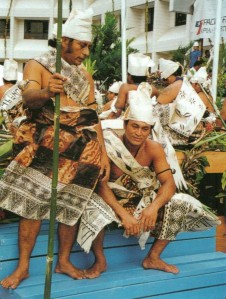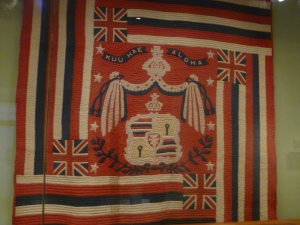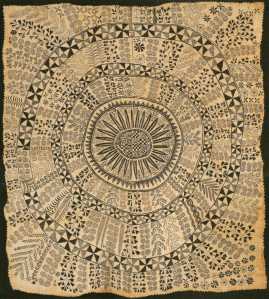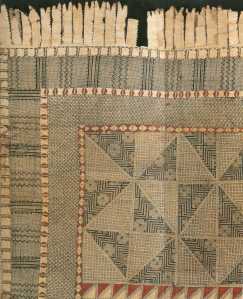kapa kulture
This blog is dedicated to Hawaiian kapa and matters related to Hawai'i nei…kuku kapa e!

Archive for the category “Mo’olelo (stories)”
Hawaiian Word of the Day: Makaliʻi
Makaliʻi: 1. Tiny, very small, fine, wee, small-meshed; narrow wefts. Makaliʻi ʻohua, tiny ʻohua, spawn: fig., anything wee, tiny. 2. Pleiades; Castor and Pollux. 3. Hawaiian month name; the six summer months collectively.
To learn more about the Makaliʻi constellation and the associated Hawaiian season of Makahiki, check out this website:
http://www.kaahelehawaii.com/pages/culture_makahiki.htm
Bark Cloth on the Island of Uvea is Ngatu
Closely related to Tonga, the term for bark cloth in the island of Uvea is ngatu. Paper mulberry, Broussonetia papyrifera, or hiapo, is cultivated on the east coast where rainfall is heavy. Double layers of ngatu are beaten out and pasted together and are designed using freehand designs or kupesi-imprinted methods. If the kupesi pattern block is used, it is made form the midrib of leaf sewn to wads of leaf as in Tonga, and this is the traditional style for Uvea to make designs on the cloth.
Contemporary kupesi are carved in wood. Freehand painting is also done. The design motifs have changed over time from simple, repetitious patterns to modern designs that show a slice of life such as drinking kava, dancing, climbing trees, and fishing. Uses of ngatu include bed covers and screens, and clothing. There are two types of wrap-around skirts that are distinct in Uvea. One called a lafi that is decorated using the kupesi and then over-painted with black dye. The second is called a tohihina, which is decorated completely with freehand design using a pen in black dye on white ngatu cloth.
Tapa in Niue
On the island of Niue, hiapo is the term for bark cloth. When Samoan missionaries came to Niue in 1830, it is recorded that they brought hiapo with them, along with the Tahitian tiputa, which is a sort of poncho. It is reasonable to believe that this cultural sharing could be a historical bridge between Samoan and the Society Islands,arising not only from Missionary influence, but also as a result of a long history of inter-island voyaging typical of canoe expeditions in the region.
Although the hiapo is said to have come originally from Samoa, the quality in Niue is different from Samoan siapo. Samples from Niue, are made by felting layers into a single sheet the way it’s done in the Cook Islands. The mystery about hiapo of Niue is that no one knows what it is made for, since the size seems to be small for clothing or blankets. Speculation has it that the very creative designs on Niuen hiapo were made for some sort of commercial purpose. Perhaps the artistry involved points to a creative purpose that served as a pastime activity? Since 1901, no hiapo has been produced in Niue.
The designs on Niuen hiapo are not made with the rubbing method. The Niuens decorated their hiapo with freehand painting that is similar to the Samoan style. Rectangular or circular design compositions with abstract forms and plant forms are drawn with fine black lines, in a grid formation. Occasionally, people, stars, and fish are also drawn into the design. Hiapo beaters found in Niue, called ike, are unique to Niue. The ike are carved with very fine grooves and shaped with a cuff on the handle.
(Neich & Pendergrast, Pacific Tapa, 1997).
Bark Cloth of the Cook Islands
Tapa is the name used for bark cloth in the Cook Islands. In the northern Cook Islands the paper mulberry did not grow well. But it did grow in the southern Cook Islands and was made into tapa there. As in other Polynesian islands, the breadfruit tree bark and banyan bark were also used to make tapa. In the southern Cooks tapa was felted into a single layer, with no sign of joining.
Decorating the finished tapa was done with freehand painting, immersion in dye baths, or it was cut with designs in a patterned motif. The rubbing method using design tablets was not used in the Cook Islands. Diamond motifs, which were “associated with the sacred world of the gods,” were applied on masks using the freehand painting method. Masks were made and decorated in Mangaia and Rarotonga and they were used in pageants called eva, to remember gods and cultural heroes. These ceremonies also were performed in association with mourning.
Tiputa was worn as clothing in the Cook Islands, in the Tahitian style that is believed to have been the result of the strong missionary influence. The tiputa was fashioned as a long piece of tapa that had a hole cut into the middle to be worn on the body like a poncho. Pants were made too. Articles of clothing were cut at the edges in fringes and cuts were made throughout the article in repetitive patterns, as in Futuna.
In the Cook Islands, as elsewhere in Polynesia, making bark cloth was done by women. However, a special, heavier, white cloth called tikoru was made by men. This was a special ceremonial bark cloth that was used to wrap around god images and was the attire of priests and high chiefs. This use may reflect the connection to spiritual beliefs that the chief and priests are descendant from the gods themselves.
(Neich & Pendergrast, Pacific Tapa, 1997).
Bark Cloth of Uvea (Wallis Island) and Futuna Island
UVEA
In Uvea, the people speak a language closely related to Tonga, the term for bark cloth in the island of Uvea is ngatu. Paper mulberry, hiapo, is cultivated on the east coast where rainfall is heavy. Double layers of ngatu are beaten out and pasted together and are designed using freehand designs or kupesi-imprinted methods. If the kupesi pattern block is used, it is made form the midrib of leaf sewn to wads of leaf as in Tonga, and this is the traditional style for Uvea to make designs on the cloth.
Contemporary kupesi are carved in wood. Freehand painting is also done. The design motifs have changed over time from simple, repetitious patterns to modern designs that show a slice of life such as drinking kava, dancing, climbing trees, and fishing. Uses of ngatu include bed covers and screens, and clothing. There are two types of wrap-around skirts that are distinct in Uvea. One called a lafi that is decorated using the kupesi and then over-painted with black dye. The second is called a tohihina, which is decorated completely with freehand design using a pen in black dye on white ngatu cloth.
FUTUNA
As in Samoa, the general term used for tapa in Futuna is siapo. The name for the paper mulberry plant is lafi. Siapo is the term used when large pieces of the cloth are made by groups of women. A salatasi identifies a smaller sheet made by a single individual that is made into a waist wrap to be worn.
The bottom of an old canoe is carved for use as a design tablet, in the style of Tonga. Designs are also applied using bamboo pens or pens made from coconut midrib. The pens are used to draw very intricate patterned designs. Ruled grids are also drawn to create squared-off areas for a variety of patterns within one piece of cloth. As a finishing touch, sometimes the edges of an article are cut into fringes.
Today, costumes for dance consist of a tepi skirt, a lafi sash worn over one shoulder, and a white turban wrap for the head. Borders on tepi skirts are sometimes created by using freehand painting with a brush and fine lines applied with a pen.

“Dancers from Futuna at the 1996 Festival of Pacific Arts, Apia Western Samoa. The dress of these dancers consists entirely of newly made tapa, from the white turban to the lafe bandolier and the tepi skirt (p.64, Pacific Tapa, R. Neich & M. Pendergrast).
Tapa from Fiji is called Masi
Fijian Masi
The term for the beaten cloth in Fiji is masi. The method for making masi is basically the same as in Tonga where it is prepared using a process of soaking and beating the inner bast of the paper mulberry (Broussonetia papyrifera) is followed by pasting the pounded sheets together for length and strength.
In the past, men commonly wore a malo or masi, which is a strip of plain white bark cloth wound around the waist and between the legs, with a train billowing behind. The longer the length of the train, the greater the chiefly status. For women, everyday clothing was a skirt called a liku. Masi is considered nearly obsolete for traditional dress since its replacement by western style clothing and textiles. Traditional dress styles using masi are not worn as everyday wear but they are still used for dances and important ceremonies like the installation of a chief, or special family occasions.
Ceremonial masi on the occasions of funerals, weddings, and chiefly ceremonies is ongoing. The bride and groom will be wrapped in long pieces of masi, in the customary fashion, and similar coverings would be worn when chiefs are installed. There is great honor associated with masi and it is a symbol of wealth. Gifts of masi are given in extravagance for marriages. It is a source of pride for the whole village to produce this exchange of wealth. Masi is very significant at death and is presented as a gift when someone dies. There is spiritual power associated with masi, as it was “recognized as having ability to carry the strength of the gods” (Fulmer, 1998).
Design work of Fijian Masi
There is a variety of techniques used in Fiji to decorate the masi. They range from freehand painting with pandanus brushes as in Samoa, to Fijian rollers and stencils, to the design tablets of Tongan influence. The finished lengths of masi decorated using rubbing tablets with midrib patterns are known as gatu vakatoga, translated as “Tongan cloth made in the Tongan way.” Gatu vakaviti is a combination of the Tongan rubbing method and the Fijian stencil application method. Gatu vakaviti literally means, “Tongan cloth in the style of Fiji” (Neich & Pendergrast, 1997).
Do you want to know more about Fiji? Here are two good articles that explain current events, traditional foundations, and colonial history:
TRADITIONAL CHIEFS REMAIN CORNERSTONE IN CHANGING FIJI
Fiji’s military ruler disbands Great Council of Chiefs
Dyes & Designs in Samoan Siapo
Faʻa Samoa…In the Samoan Way…
Natural Dye
Dyes used in Samoan siapo come from nature. They are extracted or ground from nuts, tree bark, tree sap, roots, and seeds. There are five colors collected: oʻa is brown, lama is black, ago is yellow, loa is red, and soaʻa is purple. The traditional designs are symbols that reflect Samoan natural environment. There are 13 symbols used in siapo and they represent nets, coconut leaf and sennit, the trochus shell, pandanus blooms, pandanus leaves, breadfruit leaf, sandpiper bird designs, starfish, banana pod, rolled pandanus leaves, worm (this is almost extinct), centipede (which has been discontinued), and lastly, logologo (not found in modern siapo to the point that the meaning of this design has been lost). Original siapo artworks are made by combining these design elements (siapo.com).
Design Methods
There are two kinds of siapo design application methods practiced in Samoa and they are Siapo ʻElei (the rubbing method) and Siapo Mamanu (the freehand method). The Siapo ʻElei method leaves an imprint on the uʻa (bark cloth material). This is done by laying the uʻa on a design printing block that is carved into wood, called an upeti, and rubbing the uʻa with a swab that has been dipped in oʻa. Oʻa is a brown dye that is extracted from the bark of the Bishofia javanica, or blood tree. This is a pest in the Hawaiian Islands where it is known as the Bishop Tree or is called koko (blood). It is also called koko in Tonga and other island languages. The oʻa changes color over time from a pale tan to a rich, dark brown.
The next step in the process is to rub a red color over to define the design. Arrowroot plant is used as glue and is dabbed on any small holes, and then a second layer is placed on top and rubbing the oʻa is repeated, this time pressing the two layers together. Sections are joined using arrowroot and rubbing. This is usually the end of the process for large pieces known as ululima and uluselau. But for smaller pieces called vala, the design might be highlighted with more brown dye. Upeti in the older form was of both the sewn midrib variety as in Tongan kupesi, and also carved wood. Today, the men have been carving the upeti and have become the main artist of siapo ʻelei designs. However, they still base their designs on the traditional symbols. One upeti carving can yield many different imprints as dye can be applied to certain areas only to create an interesting design using the positive and negative space (Pacific Tapa, p. 16, 1997).
Siapo Mamanu is the freehand method of design and is creatively applied by hand using a dried pandanus brush, called a paogo. The design is created by the artist using black dye to sketch the design, and then the artist may choose to use a veriety of color to finish the piece (siapo.com)
These two methods of desing can also be combined to create unique artwork that is reinvented with each piece of uʻa. Siapo is one of the oldest art forms and symbols of Samoan culture. Used for clothing, burial shrouds, bed covers, ceremonial garments, and much more… (siapo.com)
Samoan Tapa is Siapo
Siapo is the common name used for bark cloth in Samoa. The siapo is the paper mulberry tree bark for the material called uʻa. The bark is prepared in the common way of removing and preparing the bast. The tools used to beat out the uʻa is the anvil called a tutua, which is about 3 feet long for a single person to work, or six feet long for two or three people to work together. The beater used is called an is called an iʻe. The iʻe has two smooth sides and two grooved sides. After the uʻa is beaten into a sheet, it is dried in the sun and made ready for design applications.
Would you like to learn more about this topic? Check out this amazing website full of great info: siapo.com
-
Recent Posts
Archives
Categories
Meta













